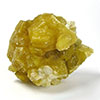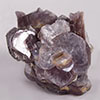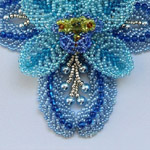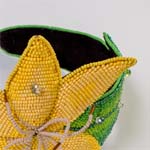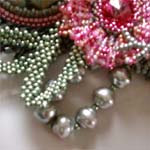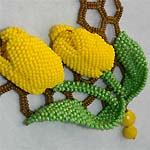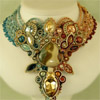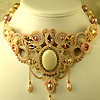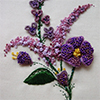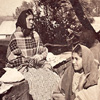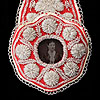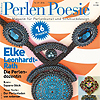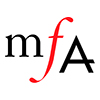May, 2016

From MyLovelyBeads.com with LoveSummer, after all, is a time when wonderful things can happen to people! For those few months you're not required to be who everyone thinks you are. Summer just opens the door and lets you free! Read in the May's issue:
Lepidolite - source of the lightest metal
Contact us with any questions at
info@mylovelybeads.com.
Fashion Colorworks. Submission finished! Mixing techniques makes me happy - C. Cattaneo History of raised bead embroidery Perlen Poesie Magazine. Issue 29 Upcoming events Best regards,
MyLovelyBeads.com Team |
Lepidolite - source of the lightest metalLepidolite is a lithium-rich mica known for its pink and lilac colors. The other colors of it can be purple, rose-red, violet-gray, yellowish, white, and colorless. Lepidolite has a vitreous (glass-like) to pearly luster. Since lepidolite is a mica material, it is not defined as stone. Lepidolite was first discovered in the 18th century in Moravia, Czech Republic, where it was called "lilalite" because of its lavender color. In 1861 Robert Bunsen and Gustav Kirchhoff extracted 150 kg (330 lb.) of lepidolite and yielded a few grams of rubidium salts for analysis, and therefore discovered the new element rubidium. However, in 1792 it was named "lepidolite" by scientist Martin Klaproth, from the Greek words LEPIDOS for "scale" and LITHOS for "stone", referring to its scaly appearance caused by flakes of lithium. It is a common matrix material to Tourmaline and Quartz, providing them with a very aesthetic and glittery base. A pink variety of the related mica mineral muscovite can be identical in appearance to lepidolite, and is many times incorrectly labeled as lepidolite. Lepidolite is an important source of lithium, which is the lightest metal in the world. Lithium is used in rechargeable batteries, aircraft parts and domestic appliances, such as toasters and microwave ovens. Lithium compounds are also used in mobile phones, air purifiers, high temperature lubricants and mood-stabilizing drugs. Fine-grained masses are sometimes polished into paperweights, ashtrays, ornaments such as eggs or spheres, or animal carvings, and cabochons. As a rule, it is not faceted. It can also be tumbled and drilled. Some of the best examples of lepidolite come from the gem-bearing pegmatites of Minas Gerais, Brazil. Notable occurrences include Russia, Canada, and Japan. Significant lepidolite specimens come from Afghanistan; three important African occurrences are Madagascar, Zimbabwe, and Mozambique. In Europe, very good lepidolite comes from Sweden, Portugal, Germany, Finland, and the Czech Republic. In the USA, the rich lepidolite localities include the states of California, Connecticut, Maine, South Dakota, and Colorado. |
||||||||
Fashion Colorworks 2016. Submission finished!
Submission for the Fashion Colorworks 2016 finished! Thank you all artists who decided to participate in this exciting competition and submitted his artwork. The next milestone is to announce the finalists - it's going to be in two weeks, on June 25. Please wait for a while! |
||||||||
Mixing techniques makes me happyWhen you try to imagine macrame, bead embroidery and weaving, and frivolite, and some other techniques mixed up in one piece of jewelry, you'll think of that, "Complete mess!" Please, stop! When you see beadworks designed by the Italian artist Claudia Cattaneo you'll change your mind. To tell the truth, we have tracked her creativity since about 2011 and must confess she made great success and became one of the most prominent bead artists. Meet Claudia and enjoy her beadworks! Claudia says, "As a child, I loved to do something and experiment, watch my grandmother knitting a sweater and my mother sewing skirts and blouses. All I have created with my own hands, even if it was not quite beautifully done, gave me some peace of mind and a sense of pride: from sand castles built on the sea coast to the doll, dressed in clothes made from scraps of fabric, and "houses" built of the large and small cardboard boxes. When I grew up, my passion for "do-it-yourself" has grown into something more serious and began to take an important part of my life and in the end, luckily, became my profession! I remember one time, more than 10 years ago, I was surfing the Internet and I was struck by the masterpieces of Sherry Serafini - it was awesome! That time in Italy it was not easy to find beads and crystals even for a small bracelet. I started looking for beading stuff the best materials, preferring silver and semi-precious stones, crystal elements and Miyuki beads. Ten years ago, it was the risk of wasting time, but now I am happy that I made this choice then. I started working on tutorials from the Bead&Button Magazine and tried to repeat what I've seen on the Internet. With great desire, I dedicated every second of my free time to beading, analyzing and studying various techniques to create my own patterns and design unique jewelry pieces already more technically complicated. My first technique I learned was peyote stitch because it was the most common technique among the artists I knew, later it was the turn of herringbone and brick stitches. And then, when I started working with threads, silk and soutache, and acquired the relevant knowledge, my creative world didn't have boundaries anymore! With new styles, such as frivolite and macrame, I began to create necklaces and bracelets in mixed techniques, and it was for me a great joy..."
Full article by Claudia Cattaneo
|
||||||||
History of raised bead embroideryLately an embroidery (including bead embroidery) style which is called STUMPWORK is gaining popularity. Stumpwork is a style where the stitched figures are raised from the surface of the work to form a three-dimensional effect, nevertheless it is not entirely correct to call it "3-D embroidery." The second name of the style is RAISED EMBROIDERY, and it seems to be more understandable and suitable. One of the ways to make stumpwork is to work embroidery on a convex surface (stuffed areas) which can be created using padding under the stitches, usually in the form of felt (or fabric) layers sewn one upon the other in increasingly smaller sizes. The felt is then covered with a layer of stitches in traditional embroidery techniques. Frankly, stumpwork is understood in a broader sense. Stumpwork is also a style of embroidery where the elements don't "lie" on the surface but "elevated" over the base and also create three-dimensional effect. In this case, stitches can be worked around pieces of wire or by "filling" wire loops to create separate elements such as leaves, insect wings or flower petals. These pre-stitched pieces are then applied to the main body of work by piercing the background with wire ends and securing tightly. The stitches used in stumpwork range from simple line stitches to more complex ones. The results of raised embroidery are seen on the photo 1. Raised embroidery originated hundreds of years ago in England, developed techniques were based on the Elizabethan embroidery. This style was particularly popular in the period between the 15th and 17th centuries, in the middle of the 18th century it went out of fashion. Using raised embroidery, craftsmen create impressive and realistic floral images and even stylized scenic pictures that included plants, animals, flowers, insects, birds, fruits and berries, people in complex clothing and even buildings (castles, houses, and so on). Raised embroidery with beads received interesting development in North America, when in the mid-19th century it became a real business among Iroquois Indians, especially in the Tuscarora tribe. Tuscarora people is one of six Nations of the Iroquois Six Nations Confederacy); at the beginning of the 18th century they were driven from the territory of the present state of North Carolina and migrated to the north, particularly to the area of the Niagara River between lakes Erie and Ontario. Selling beadwork and other handmade crafts is a long tradition among the North American Indians, but Tuscarora women have received international acclaim because of raised bead embroidery ("Tuscarora beadwork"). They were able to organize handicraft production and trade with beaded souvenirs for Victorian period tourists, visiting Niagara Falls in the nineteenth century. Skilled workers made pincushions, small handbags, wall holders, earrings and other jewelry, and selling these souvenirs in the most convenient places to watch the famous waterfall. |
||||||||
Perlen Poesie Magazine. Issue 29PERLEN POESIE 29 is already live! Filled with design ideas for the summer! Find 16 jewelry projects to brandish your needles at: pretty necklaces, pendants, earrings and bracelets, as well as ideas for adorning the hair. The German designer Elke Leonhardt-Rath has many inspiration on hand, and a terrific graphically designed jewelry piece to work. This issue's course covers square stitch.
• Improve your skills
You love loom work jewelry but you have no beading loom or you think securing all these pesky threads is a nuisance? Then you will like the stable square stitch: it allows you to make a lot of things - from pieces of jewelry to fashion accessories like belts. • Life Inside - a jewelry set Enjoy this unusual testimony of artistic expressiveness. It tells a story of destruction and new life. • Impressions Fair 2016: An abundance of workshops in various techniques, a joint project, a large exhibition of jewelry and enchanting jewelry performances characterized the BEADERS BEST Bead Art Fair in Stuttgart.
Subscribe to Perlen Poesie magazine
|
||||||||
Upcoming eventsIntroducing Fiber Options: Material Explorations
July 14 - August 6, 2016 From July 14 to August 6, MFA (Maryland Federation of Art) holds its 4th biennial Fiber Options: Material Explorations exhibition. Selected artists residing in the United States, Puerto Rico, Canada and Mexico will exhibit original 2-D and 3-D artworks created with fiber and fiber techniques there. |
||||||||
Note
If you don't see the newsletter properly formatted please click here:
May Issue
|
||||||||
© 2016 MyLovelyBeads.com All Rights Reserved.
If you do not want receive our newsletter and you wish to remove your email address from our mailing list, please click the following link to unsubscribe.



